Zscaler Blog
Get the latest Zscaler blog updates in your inbox
A Look Into DuckTail
Introduction
In our persistent quest to decode DuckTail’s maneuvers, Zscaler ThreatLabz began an intelligence collection operation in May 2023. Through an intensive three-month period of monitoring, we obtained critical details about DuckTail’s operational framework. This expedition granted us unprecedented visibility into DuckTail’s end-to-end operations, spanning the entire kill chain from reconnaissance to post-compromise.
Our team yielded valuable insights into DuckTail’s intrusion techniques, compromise tactics, post-compromise procedures, and the underground economy. These insights, some of which have never been publicly documented, provide a panoramic view of their targets and an understanding of their strategic motives.
This report dives into the operational mechanics of DuckTail, dissecting the anatomy of their tactics, techniques and procedures (TTPs), and tracing the trajectory of stolen data.
Key Takeaways
- Ideal Social Engineering Target: DuckTail threat actors primarily target users working in the digital marketing and advertising space. Unfortunately, the tech layoffs occurring in 2022 and 2023 introduced more eager candidates into the digital market - meaning more prime targets for DuckTail.
- Raiding Business and Ad Accounts: DuckTail targets Facebook and TikTok business accounts, and Google ad accounts. Stolen social media business accounts feed an underground economy where these accounts are traded among other users in Vietnamese Telegram groups.
- Social Engineering as the Distribution Method: DuckTail’s primary distribution vector continues to be social engineering through LinkedIn messaging. Threat actors set up fake LinkedIn recruiter profiles and fake job postings impersonating popular companies to lure unsuspecting victims looking for employment.
- Expanding and Always Evolving: DuckTail continues to expand the list of cloud services abused for hosting and distributing payloads.
- Exploiting Themes of Innovative AI Online Tools: DuckTail threat actors have successfully weaponized the recent popularity of generative AI platforms, such as ChatGPT and Google Bard AI, to lure victims to install malicious software.
- Stealthy and Strategic Maneuvers: DuckTail threat actors use private residential proxy services to log in to compromised social media business accounts to prevent raising any security alarms. In addition, they abuse the "Encrypted notifications" Facebook feature to prevent the victim from performing an account recovery.
Brief Overview
DuckTail is an operation that involves multiple Vietnam-based threat actors who share the same tactics, techniques, and procedures (TTPs). They also share the same motivation: gain access to social media business accounts, specifically ones belonging to digital marketers.
DuckTail malware steals saved session cookies from browsers, with code specifically tailored to take over Facebook business accounts. The malware is typically spread on LinkedIn, where threat actors post fake job descriptions to “recruit” potential victims.
The “products” of the operation (i.e. hacked social media accounts) feed an underground economy of stolen social media accounts, where numerous vendors offer accounts priced according to their perceived usefulness for malicious activity. The image below shows a high-level overview of how DuckTail threat actors abuse different cloud services and social media platforms in their whole operation:
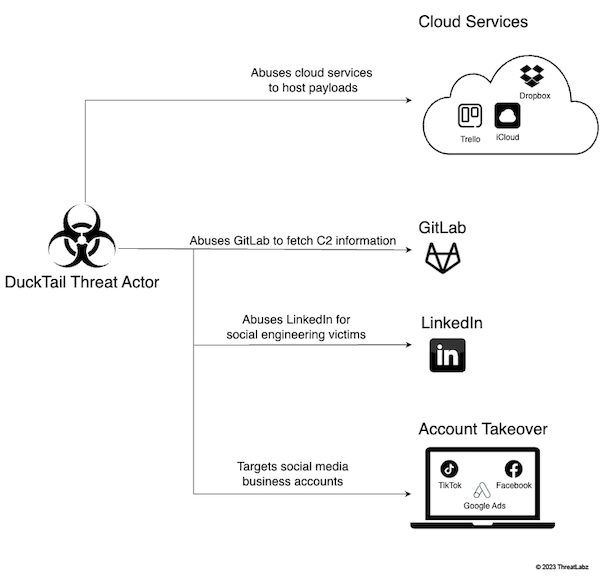
Figure 1: Visual overview illustrating how DuckTail abuses social media and cloud platforms in different stages of their operation.
Unveiling DuckTail’s TTPs
Overview of the architecture
The threat research community is already abundant with great articles that address the technical details of DuckTail’s malware payload.
Distribution methods and techniques
The following sections break down:
- the infection vectors employed by Ducktail
- what those infection campaigns look like
Fake Job Posts on LinkedIn
DuckTail primarily reaches victims by posting fake marketing-related job listings on LinkedIn. The threat actors presume that the marketing professionals who apply likely have access to ad accounts. The image below is an example of a fake job post on LinkedIn used by Ducktail to lure an unsuspecting candidate.
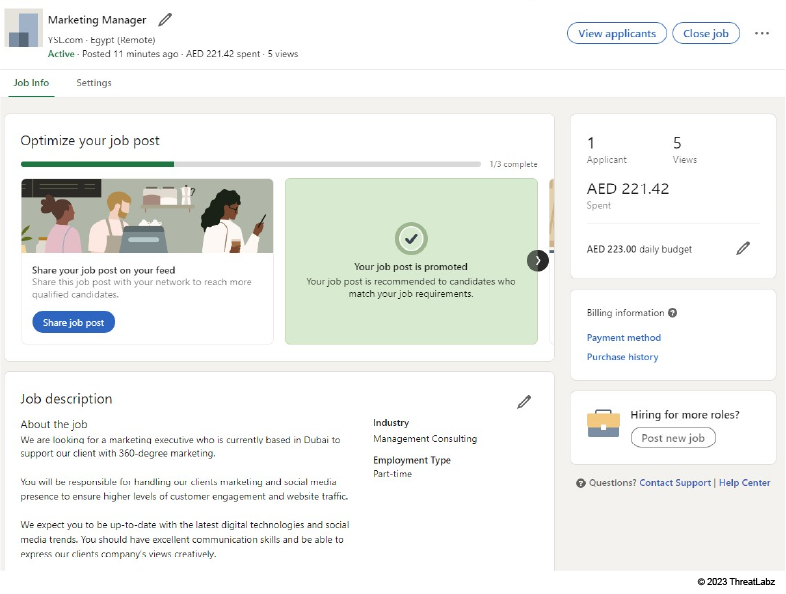
Figure 2: This is what the threat actor sees moments after setting up a fake marketing job post on LinkedIn. It’s worth noting that the post is promoted.
In addition to creating fake job posts on LinkedIn, threat actors also set up profiles on LinkedIn impersonating recruiters. To facilitate social engineering tactics, in some cases, threat actors add the “Hiring” banner to their LinkedIn profile picture. This catches the attention of users actively seeking a new job.
Once a potential victim responds to a bait post, the “recruiter” will send a message on LinkedIn.
How it works
The threat actors will ask the interested applicant to review the job application package by:
- Downloading an archive
- Opening it on a Windows machine
- Double-clicking the executable (camouflaged as another type of file) inside it
To maximize their chance of infection, some threat actors create instructional videos showing victims how to “properly” infect their own devices. The image below shows this tactic in action:
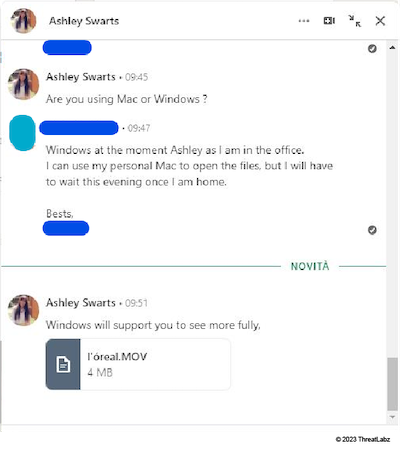
Figure 3: “Ashley Swarts” (a fake threat actor account) instructing a victim on how to open the fake job application package.
The nuances of language
The threat actor’s English proficiency closely matches the English language skills of an average Vietnamese cybercriminal, not an American HR professional.
Our team observed threat actors using Google Translate to communicate with potential victims. The image below shows a threat actor translating messages from English to Vietnamese in real-time as they communicate with a victim. The predominant use of the Vietnamese language also supports our attributing DuckTail to Vietnamese threat actors.

Figure 4: A threat actor using Google Translate to communicate in English while handling multiple fraudulent job application conversations on LinkedIn.
Impersonating real companies
DuckTail threat actors send job offers impersonating popular organizations and brands to entice job seekers.
In the image below, a threat actor leveraged a compromised LinkedIn account to message a victim with job opportunity details. While impersonating a real company called Mondelez International, this threat actor sent the following in their message:
- a link to the company's real Wikipedia and Facebook page
- an iCloud URL hosting an archive file containing the malware

Figure 5: A threat actor messaging a victim on LinkedIn and impersonating a real company.
Spear phishing emails
Our team also observed cases where threat actors sent infected archive links through email, after making initial contact on LinkedIn. The image below shows a spear phishing email example.

Figure 6: A spear phishing email sent to a victim containing the URL shortener link, which downloads the malicious archive file.
.NET executables as a common thread in DuckTail binaries
Most commonly, DuckTail’s malware payload is a .NET executable, but this is not always the case. Some Ducktail payloads come in an Excel add-in or browser extension.
The .NET executables family associated with the Ducktail variants share the following attributes:
- Large file sizes, in most cases - around 70 MB or more
- Includes a fake Office or PDF document icon
- Contains a decoy document with details about the fake job offer/marketing advertisement, which opens right after execution
- Signed with valid code-signing certificates belonging to Vietnamese publishers (sometimes)
- Makes use of Telegram for C2 communications
The executable is usually delivered in an archive, together with image and video files. The images below depict two common archive variations.
Type 1 Archive
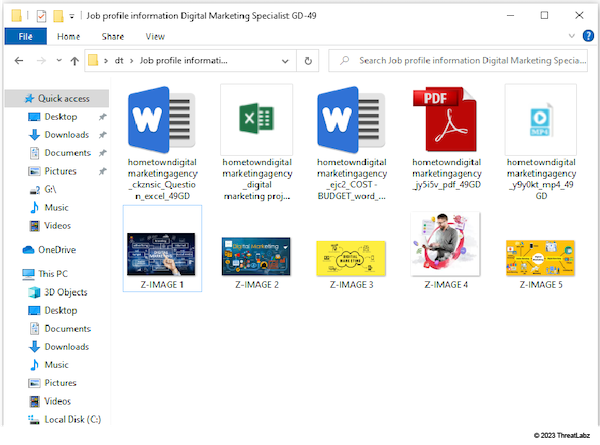
Figure 7: Type 1 Archive - .exe files with fake icons (first row), together with job-related images
Type 2 Archive
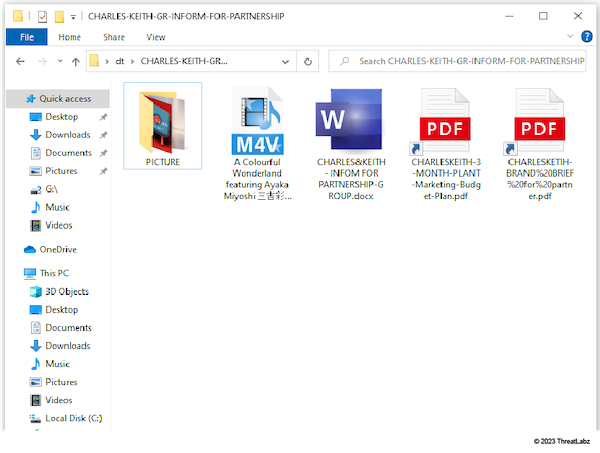
Figure 8: Type 2 Archive - .lnk files with PowerShell payloads, plus .scr executables, both obscured by double extensions (.pdf.lnk, .docx.scr), together with job-related images
Cloud hosting and URL shortening services
Our research team noticed the following patterns when investigating DuckTail’s infrastructure:
- Malicious archives are often hosted on public cloud hosting services like iCloud, Google Drive, Dropbox, Transfer.sh, and OneDrive.
- In some cases, threat actors use Trello, a project management platform, as a cloud hosting service by uploading archives as attachments to Trello cards and providing victims with a direct download link to the card.
- Another widely abused platform is Rebrandly (rebrand.ly) - a URL shortener service. Threat actors spread download links generated by Rebrandly to give the download a more legitimate look. You can see the difference that Rebrandly makes in the image below.

Figure 9: A redirection chain set up by the threat actor transforms a long, unfriendly Dropbox link into a short rebrand.ly link.
Newly registered domains used to host payloads
In addition to disguising links with Rebrandly, threat actors also registered many custom domains through Rebrandly, spreading shortened links with their own fake company name domains.
Most of these custom domains registered by the threat actor use TLDs like:
- .social
- .software
- .sale
- .click
- .news
- .agency
- .company
For a complete list of newly registered domains used by DuckTail, visit the Indicators of Compromise (IOCs) section at the bottom of this blog.
Marketing guides and AI tools
Another method of infection is the creation of web pages pretending to offer marketing guides and marketing software, but actually serving DuckTail malware.
We observed the following legitimate marketing and AI tools spoofed:
- Adplexity
- ClickMinded
- ChatGPT
- Google BardAI
Generative AI softwares, like ChatGPT, are prime targets because they are being increasingly utilized by professionals working in digital marketing, content creation, and advertising.
The image below shows a web page created by a threat actor leveraging ChatGPT for Facebook advertising.

Figure 10: A screenshot of newguide[.]tech, a website set up by Ducktail to leverage ChatGPT.
Below, there is another example of a website set up by a threat actor impersonating Adplexity.

Figure 11: A screenshot of adplexitydesk[.]tech, a website set up by Ducktail impersonating Adplexity. The download button leads to a Ducktail infected archive.
Insights Gained
In the following sections, we share insights about the threat actors operating DuckTail and the strategies they employ.
Primary targets and industries
While Ducktail is mostly known for targeting Facebook users, we observed threat actors stealing and abusing access to victim accounts on other advertising platforms, namely TikTok Business and Google Ads. This ability to pilfer multiple platforms is due to Ducktail’s general-purpose cookie stealing capabilities.
Communication channels and techniques
The threat actors use the following platforms to communicate and trade stolen information:
- Telegram
- Zalo (a Vietnamese messaging app)
The threat actors set up Telegram bots to automatically handle data arriving from new victims. This allows them to pinpoint the most important information, like:
- the victim’s Facebook account information
- the number of detected ad accounts
- business manager accounts
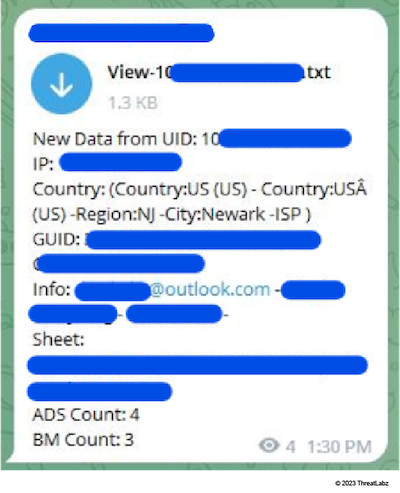
Figure 12: A bot introduces a new victim’s Facebook profile. An American with control over four personal ad accounts and three business manager accounts.
Infiltration strategies
Adding threat actor email addresses to compromised accounts
One of the primary methods threat actors use to takeover a victim’s compromised account is by adding their own email address to that account.
In the image below, Facebook emailed a security notification to a victim informing them that a threat actor has added an email address to their account.
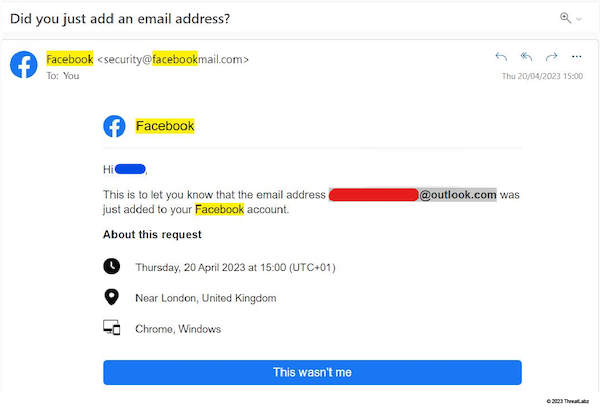
Figure 13: This screenshot shows a security notification warning a victim about a new email address added to their account - indicating that a Ducktail threat actor has begun a takeover of their Facebook account.
Updating password and email for compromised accounts
DuckTail threat actors change the password and email address of a Facebook account during takeover.
Abusing Facebook Encrypted Notifications feature
We observed an instance where, after taking over a victim’s Facebook account, the threat actor enabled the Encrypted Notifications setting. This way every Facebook email communication with the victim is encrypted - effectively preventing the victim from recovering their account.
Using compromised LinkedIn accounts for communication
While investigating communication between threat actors and victims on LinkedIn, we came across instances where threat actors contacted victims using compromised LinkedIn accounts.
These compromised LinkedIn accounts belonged to users working in the digital marketing space. Some of the compromised LinkedIn accounts had more than 500 connections and 1000 followers. The high amount of connections/followers helped lend authenticity to the compromised accounts and facilitated the social engineering process for threat actors.
How are the threat actors compromising LinkedIn accounts?
- We believe, with a medium-confidence level, that some of these compromised LinkedIn accounts were purchased in underground markets by DuckTail threat actors. We discovered an internal budgeting spreadsheet used by the DuckTail team which details their revenue and expenditures. One of the entries in the spreadsheet corresponded to the purchase of LinkedIn accounts.
- We believe, with a high-confidence level, that threat actors are compromising the LinkedIn accounts of users who fell victim to DuckTail’s initial attack where victims were enticed with fraudulent job posts and fake recruiters. We reached this conclusion after observing a conversation between members of the DuckTail group. One member directed another member to access a victim's Gmail account (using the stolen browser cookies), delete email entries related to LinkedIn (to clear traces), and change the account recovery email address to an attacker-controlled email.
Compromising TikTok business accounts
The image below shows the activity log page of a victim’s compromised TikTok Business account. The log depicts the threat actor inviting themselves to control the account and then performing actions. After three days, the targeted business notices and revokes their access.
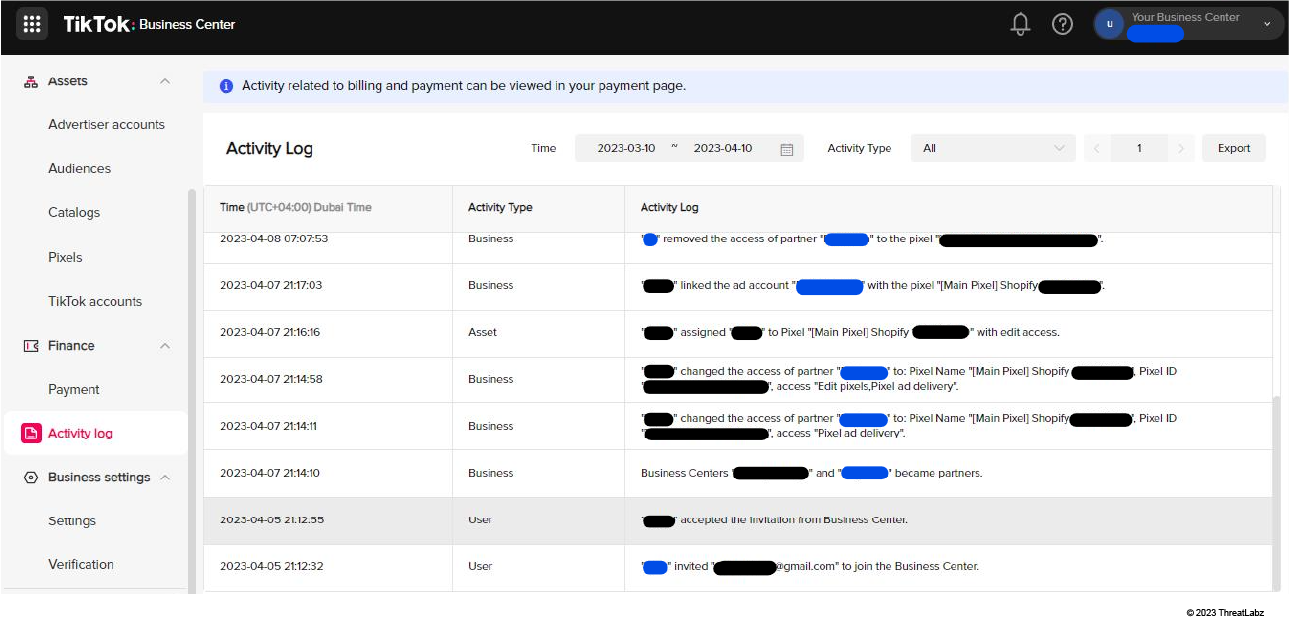
Figure 14: This is a TikTok business center activity log for a compromised account, showing the actions executed by the threat actor.
Leveraging residential proxy services to access compromised accounts
Our team observed DuckTail threat actors using “Residential Proxy” services to circumvent Facebook account compromise detections.
In the image below, the attacker’s machine uses the “S5 Proxy” residential proxy service from the vendor - 922proxy.com. Interestingly, the UI also shows the threat actor’s own original IP address. We confirmed with an IP geolocation lookup that the threat actor’s original IP address maps to a city in Vietnam, further strengthening our theory that DuckTail is operated by Vietnam-based threat actors.
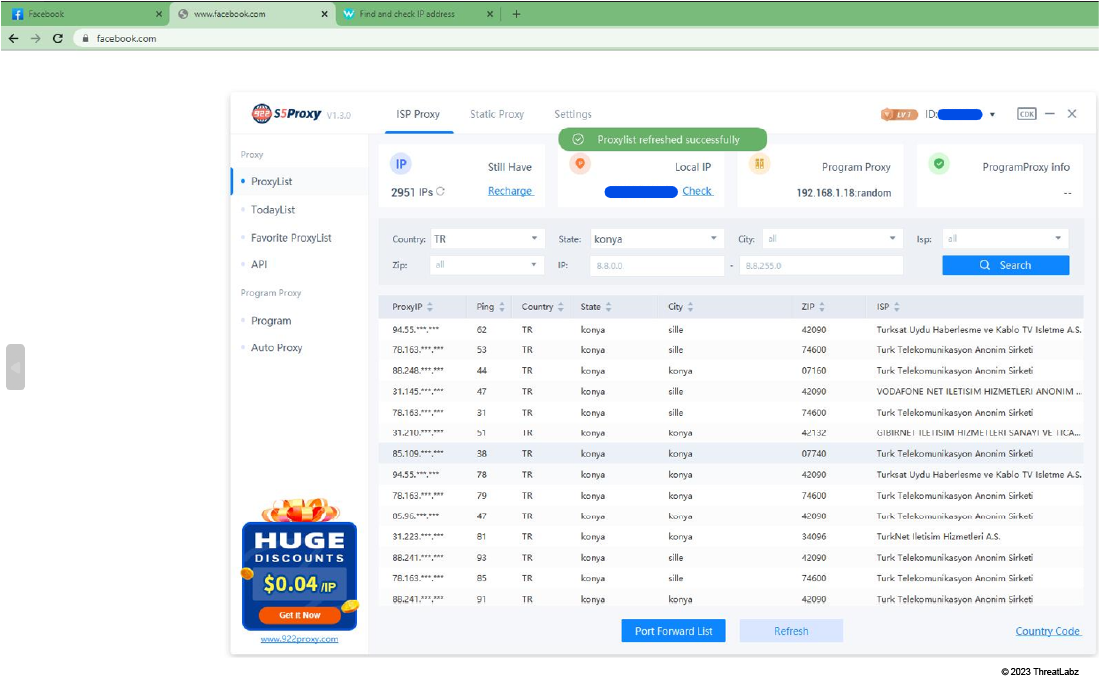
Figure 15: This screenshot shows a threat actor connecting to a residential proxy in Konya, Turkey, before logging into the compromised Facebook account of a victim.
Stolen Credentials Enter Underground Market
Social media ad accounts are constantly targeted for hacking. Threat actors, like those behind the Ducktail operation, collect massive amounts of hacked accounts. But where do they end up?
Hacked social media and ad accounts end up for sale in a busy Vietnamese-language underground market. Here is what we know about this market:
- Mainly Facebook accounts are sold
- It includes numerous publicly accessible Telegram groups
- DuckTail threat actors are active sellers
Despite the illicit nature of these groups, they are public and easily accessible. Although it may be difficult for a novice to interpret the jargon and abbreviations that are heavily used in the community.
Awareness of OPSEC among those involved appears to be be lacking or non-existent.

Figure 16: In this screenshot, vendors offer access to hacked Facebook accounts on a Vietnamese Telegram group.
Threat actors target ad accounts so they can access ad budgets. High ad budgets and long-term accessibility to accounts are attractive characteristics to threat actors.
Facebook combats threat actors like Ducktail, who hack and abuse ad accounts on their platform, by automatically flagging suspicious accounts. Because of this, threat actors try to prolong the life of a compromised ad account. For this reason, hacked Facebook accounts are not interchangeable commodities. Depending on an account’s properties, it may range from very valuable to almost useless to buyers.
Here are common properties that vendors and buyers check for in this underground market:
- The type of account (a personal ad account or a business manager account)
- The daily ad budget and payment threshold of an account
- The number of ad accounts a business manager account controls
- A successful business verification by Facebook
- If the account controls a page or profile with a verified badge
- The age of the account. Older accounts are more valuable than younger.
- The existence and validity of saved payment methods
- The account’s successful payment history. More successful payments indicate a more valuable account.
We observed the following Vietnamese browser extension used for displaying account properties:

Figure 17: A screenshot of the Vietnamese-designed browser extension used by threat actors to quickly assess social media business account details.
Payments and Transactions
We observed that an account deemed “low-grade” sells for around 350,000 Vietnamese dong (~$15 USD), while accounts considered valuable sell for around 8,000,000 Vietnamese dong (~$340 USD).
When a transaction is complete, the seller hands over control of the hacked account by:
- Adding/inviting the buyer to control the account through Facebook (business manager)
- Providing the victim’s login and password to the compromised account
- Providing the victim’s exported browser cookies, thus replicating their logged-in session
If the level of compromise is thorough, access to the victim’s email may be given on top of the above to maintain access even longer, and also be able to bypass MFA security measures.
Conclusion
In this blog, ThreatLabz provides a wealth of new insight for the research community. Understanding the operational methods and end-to-end journey of a threat actor like DuckTail is a form of protection. Because of our research team, we can confidently state:
- DuckTail is primarily run by Vietnamese-speaking cyber criminals who use Google Translate to communicate with potential victims over LinkedIn.
- DuckTail threat actors target personal, business, and ad accounts on platforms like TikTok, Facebook, LinkedIn, and Google, and use social engineering to infect devices.
- DuckTail threat actors are abusing themes of popular AI tools, like ChatGPT, to infect devices.
- DuckTail threat actors take extra measures to prevent raising security alarms by using private residential proxy services to log in to compromised accounts.
- DuckTail threat actors use strategic account takeover methods which they routinely use in their post-compromise procedures to prevent any form of account recovery by victims
- Hacked and/or compromised social media business ad accounts enter a primarily Vietnamese-based underground market where they are sold based on their perceived value.
- You can take steps to minimize the impact of a hacker by managing your saved payment methods in business ad accounts and making use of safeguards like daily spending limits, payment thresholds, etc.
In addition to staying on top of these threats, Zscaler's ThreatLabz team continuously monitors for new threats and shares its findings with the wider community.
Zscaler Sandbox Detection
The figure below shows the sandbox detection for the Windows shortcut (LNK) file which is used to kick start the DuckTail infection chain.

Figure 18: Zscaler sandbox detection
In addition to sandbox detection, Zscaler’s multilayered cloud security platform detects indicators at various levels.
MITRE ATT&CK TTP Mapping
| ID | TACTIC | TECHNIQUE |
|---|---|---|
| T1204.001 | User Execution: Malicious Link |
User executes the shortcut .lnk file |
| T1204.002 | User Execution: Malicious File | User executes the attached compressed/executable file |
| T1027.001 | Obfuscated Files or Information: Binary Padding | Binary inflated in order to avoid sandboxing |
| T1036.005 | Masquerading: Match Legitimate Name or Location | Drops malicious binaries into legitimate paths |
| T1057 | Process Discovery | Checks for well known security software analysis tools |
| T1567.002 | Exfiltration Over Web Service: Exfiltration to Cloud Storage | Telegram API used to exfiltrate user data |
| T1070.006 | Indicator Removal: Timestomp | PE’s Timestamp header value are tampered |
Indicators of Compromise (IOCs)
Fake sites set up by DuckTail threat actor
- marketingagency[.]social
- a1outreach[.]software
- mangogroup[.]sale
- la-roche-posay[.]click
- li-ning[.]agency
- li-ning[.]news
- hrm[.]social
- hrms[.]social
- mccann[.]fyi
- avalonorganics[.]work
- li-ningagency[.]news
- li-ningjod[.]news
- ogilvy[.]social
- narscosmetics[.]social
- yodo1game[.]software
- louisvuitton-social[.]news
- luoisviitton[.]news
- eucerin[.]work
- guessinc[.]work
- samsungagency[.]link
- brandresource[.]social
- recruiterofbrand[.]social
- brandrecruitment[.]social
- hrmmarketing[.]link
- marketingmanager[.]social
- recruitmentagency[.]social
- marketing-project[.]social
- nike-agency[.]link
- recuiter[.]company
- louisvuitton-agency[.]link
- louisvuitton-agencyjod[.]live
- mccann[.]expert
- ogilvysocial[.]company
- louisvuitton-hr[.]news
- louisvuitton-jod[.]chat
- hyundaimotorjob[.]social
- hyundaimotor[.]social
- hyundaimotorgroup[.]social
- adplexity[.]site
- adplexitydesk[.]tech
- fbadsguide[.]tech
- affiliateguide[.]tech
- newguide[.]tech
- businessmanagerads[.]tech
- businessmanager-update[.]info
- marketing-tool[.]info
- connectads[.]agency
- disruptiveadvertising[.]agency
- impressionagency[.]co
- themars[.]social
- ommmarketing[.]agency
- growmemarketing[.]agency
- ommmarketing[.]digital
- impressiondigitals[.]agency
- impressiondigital[.]info
- passions[.]agency
- brandstyle[.]agency
- brandstyle[.]digital
Appendix
Attacker-controlled Trello account

Figure 19: An attacker-controlled Trello account used to host the malicious files. Screenshot shows the activity log.
Was this post useful?
Disclaimer: This blog post has been created by Zscaler for informational purposes only and is provided "as is" without any guarantees of accuracy, completeness or reliability. Zscaler assumes no responsibility for any errors or omissions or for any actions taken based on the information provided. Any third-party websites or resources linked in this blog post are provided for convenience only, and Zscaler is not responsible for their content or practices. All content is subject to change without notice. By accessing this blog, you agree to these terms and acknowledge your sole responsibility to verify and use the information as appropriate for your needs.
Get the latest Zscaler blog updates in your inbox
By submitting the form, you are agreeing to our privacy policy.



